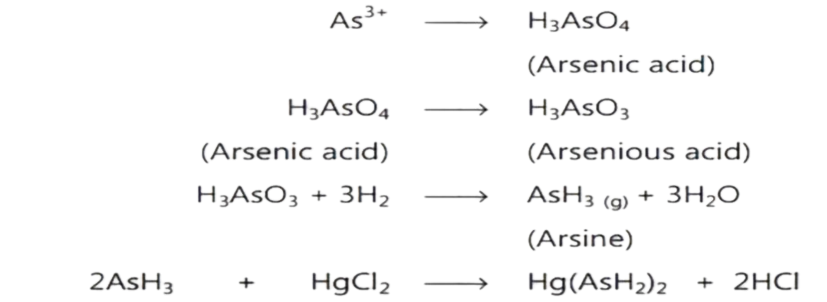The limit test for arsenic is based on the reduction of the arsenic in the arsenic state to the arsenic gas with zinc and hydrochloric acid. The arsenic gas stains the mercuric chloride paper yellow. The paper is dissolved in acid where the arsenic present as an impurity in the sample gets converted into arsenic acid.
Principle:
The limit Test for Arsenic Principle as per pharmacopeia is based on the fact that arsenic in arsenious state can be easily reduced to arsenic gas. when this gas is passed over mercuric chloride paper. it produces a stain that ranges in color from yellow to brown. the intensity and length of which are proportional to the amount of arsenic.
Reaction:
The amount of impurity present in the sample is first converted into arsenious acid by the action of reducing agents like potassium iodide, zinc, Hcl, and stannous chloride.
Then further arsenic acid is then reduced to arsine by the action of hydrogen which is produced by the reaction between zinc and HCl.

The arsine gas travels through a tube and finally reacts with mercuric chloride paper to produce a yellow stain.
The depth of the yellow stain depends on the amount of arsenic present in the sample compared with that of the standard stain produced from a known amount of arsenic.
The Reagent used in the limit test for arsenic:
All the special reagents used in the limit test for arsenic are marked and distinguished by the letter “as T” which means they all should be arsenic-free and should themselves confirm to limit test for arsenic.

Stannous chloride is used for the complete evolution of arsine.
Zinc. potassium iodide and stannous hydrochloric acid are used as reducing agents. arsenic is reduced to the arsine by the combined action of these reagents.
Lead acetate-soaked cotton plug is used to trap any hydrogen sulfide that may be evolved along with arsenic.
Apparatus:
Limit Test for Arsenic is performed by an apparatus known as a Gutzeit apparatus. it is also called an arsenic apparatus.
The apparatus bottle consists of a wide-mounted glass bottle of 120 ml capacity having a mouth of about 2.5 cm in diameter, a tube with an internal diameter of 6.5 mm, and an outer diameter is 8.0 mm.
Procedure:
| Standard | Test solution |
|---|---|
| Add 1 ml standard solution of Arsenic (10 ppm) in 50 ml water. | Dissolved sample in 50 ml water. |
| Add 10 ml of Stannous Hcl acid. | Add 10 ml of Stannous Hcl acid. |
| Add a further 1 gm of Potassium iodide + 10 gm of granulated zinc. | Add a further 1 gm of Potassium iodide + 10 gm of granulated zinc. |
| Place in Gutzeit Apparatus for 40 minutes. | Place in Gutzeit Apparatus for 40 minutes. |
Result:
After 40 minutes, we will compare the mercuric chloride paper of both. the test has less strain as compared with the standard to pass the limit test.
Related: Limit Test for Sulphate/ Limit Test for Chloride/ Limit Test for Iron
Note: PDF and Notes on Limit Test for Arsenic will be available soon.

Naresh Bhakar is the Founder and Author at Pharmaguddu.com, bringing his extensive expertise in the field of pharmaceuticals to readers worldwide. He has experience in Pharma manufacturing and has worked with top Pharmaceuticals. He has rich knowledge and provides valuable insights and data through his articles and content on Pharmaguddu.com. For further inquiries or collaborations, please don’t hesitate to reach out via email at [email protected].
